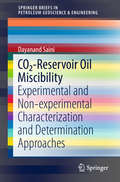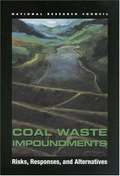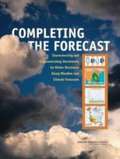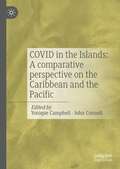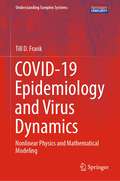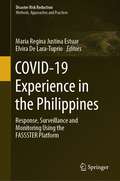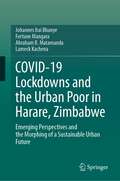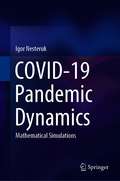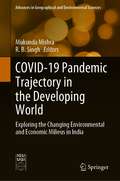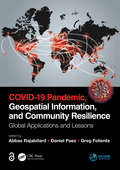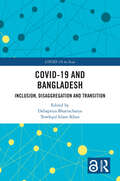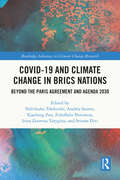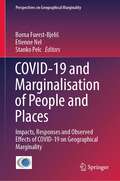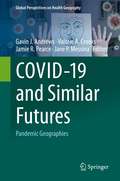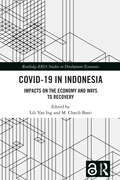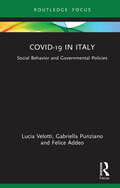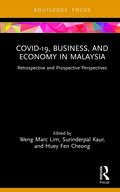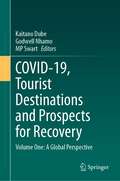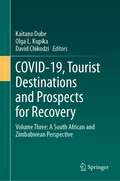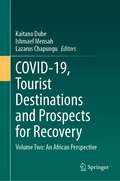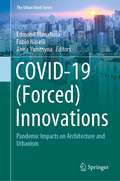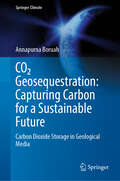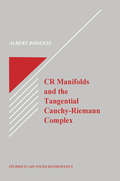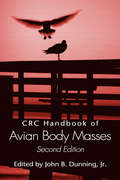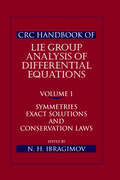- Table View
- List View
CO2-Reservoir Oil Miscibility: Experimental and Non-experimental Characterization and Determination Approaches (SpringerBriefs in Petroleum Geoscience & Engineering)
by Dayanand SainiThis SpringerBrief critically examines the latest experimental and non-experimental approaches used for the fast and reliable characterization and determination of CO2-reservoir oil miscibility in terms of the minimum miscibility pressure (MMP). This book serves as a one-stop source for developing an enhanced understanding of these available methods, and specifically documents, analyses, and evaluates their suitability and robustness for depicting and characterizing the phenomenon of CO2-reservoir oil miscibility in a fast and cost-effective manner. Such information can greatly assist a project team in selecting an appropriate MMP determination method as per the project’s need at a given project’s stage, be that screening, design, or implementation. CO2-Reservoir Oil Miscibility: Experiential and Non-Experimental Characterization and Determination Approaches will be of interest to petroleum science and engineering professionals, researchers, and undergraduate and graduate students engaged in CO2 enhanced oil recovery (EOR) and/or simultaneous CO2-EOR and storage projects and related research. It may also be of interest to engineering and management professionals within the petroleum industry who have responsibility for implementing CO2-EOR projects.
COAL WASTE IMPOUNDMENTS: Risks, Responses, and Alternatives
by Committee on Coal Waste ImpoundmentsOn October 11, 2000, a breakthrough of Martin County Coal Corporation’s coal waste impoundment released 250 million gallons of slurry in near Inez, Kentucky. The 72-acre surface impoundment for coal processing waste materials broke through into a nearby underground coal mine. Although the spill caused no loss of human life, environmental damage was significant, and local water supplies were disrupted. This incident prompted Congress to request the National Research Council to examine ways to reduce the potential for similar accidents in the future. This book covers the engineering practices and standards for coal waste impoundments and ways to evaluate, improve, and monitor them; the accuracy of mine maps and ways to improve surveying and mapping of mines; and alternative technologies for coal slurry disposal and utilization. The book contains advice for multiple audiences, including the Mine Safety and Health Administration, the Office of Surface Mining, and other federal agencies; state and local policymakers and regulators; the coal industry and its consultants; and scientists and engineers.
COMPLETING THE FORECAST: Characterizing and Communicating Uncertainty for Better Decisions Using Weather and Climate Forecasts
by National Research Council of the National AcademiesUncertainty is a fundamental characteristic of weather, seasonal climate, and hydrological prediction, and no forecast is complete without a description of its uncertainty. Effective communication of uncertainty helps people better understand the likelihood of a particular event and improves their ability to make decisions based on the forecast. Nonetheless, for decades, users of these forecasts have been conditioned to receive incomplete information about uncertainty. They have become used to single-valued (deterministic) forecasts (e.g., "the high temperature will be 70 degrees Farenheit 9 days from now") and applied their own experience in determining how much confidence to place in the forecast. Most forecast products from the public and private sectors, including those from the National Oceanographic and Atmospheric Administration’s National Weather Service, continue this deterministic legacy. Fortunately, the National Weather Service and others in the prediction community have recognized the need to view uncertainty as a fundamental part of forecasts. By partnering with other segments of the community to understand user needs, generate relevant and rich informational products, and utilize effective communication vehicles, the National Weather Service can take a leading role in the transition to widespread, effective incorporation of uncertainty information into predictions. "Completing the Forecast" makes recommendations to the National Weather Service and the broader prediction community on how to make this transition.
COVID in the Islands: A comparative perspective on the Caribbean and the Pacific
by John Connell Yonique CampbellThis book provides the first wide-ranging account of the impact of the COVID-19 pandemic in two contrasting island regions - the Caribbean and the Pacific - and in several islands and island states. It traces the complexity of effects and responses, at different scales, through the first critical year. Written by a range of scholars and practitioners working in the region the book focuses on six key themes: public health; the economies (notably the collapse of tourism, the revival of local agriculture and fishing, and the rebirth of self-reliance, and even barter); the rescue by remittances; social tensions and responses; public policy; and future ‘bubbles’ and regional connections. Even with marine borders that excluded the virus all island states were affected by COVID-19 because of a considerable dependence on tourism – prompting urgent challenges for governance, economic management and development, as small states sought to balance lives against livelihoods in search of revitalisation or even a ‘new normal’.
COVID-19 Epidemiology and Virus Dynamics: Nonlinear Physics and Mathematical Modeling (Understanding Complex Systems)
by Till D. FrankThis book addresses the COVID-19 pandemic from a quantitative perspective based on mathematical models and methods largely used in nonlinear physics. It aims to study COVID-19 epidemics in countries and SARS-CoV-2 infections in individuals from the nonlinear physics perspective and to model explicitly COVID-19 data observed in countries and virus load data observed in COVID-19 patients. The first part of this book provides a short technical introduction into amplitude spaces given by eigenvalues, eigenvectors, and amplitudes.In the second part of the book, mathematical models of epidemiology are introduced such as the SIR and SEIR models and applied to describe COVID-19 epidemics in various countries around the world. In the third part of the book, virus dynamics models are considered and applied to infections in COVID-19 patients. This book is written for researchers, modellers, and graduate students in physics and medicine, epidemiology and virology, biology, applied mathematics, and computer sciences. This book identifies the relevant mechanisms behind past COVID-19 outbreaks and in doing so can help efforts to stop future COVID-19 outbreaks and other epidemic outbreaks. Likewise, this book points out the physics underlying SARS-CoV-2 infections in patients and in doing so supports a physics perspective to address human immune reactions to SARS-CoV-2 infections and similar virus infections.
COVID-19 Experience in the Philippines: Response, Surveillance and Monitoring Using the FASSSTER Platform (Disaster Risk Reduction)
by Maria Regina Justina Estuar Elvira De Lara-TuprioThis book provides an overview of the extensive work that has been done on the design and implementation of the COVID-19 Philippines Local Government Unit Monitoring Platform, more commonly known as Feasibility Analysis of Syndromic Surveillance Using Spatio-Temporal Epidemiological Modeler for Early Detection of Diseases (FASSSTER). The project began in 2016 as a pilot study in developing a multidimensional approach in disease modeling requiring the development of an interoperable platform to accommodate input of data from various sources including electronic medical records, various disease surveillance systems, social media, online news, and weather data. In 2020, the FASSSTER platform was reconfigured for use in the COVID-19 pandemic. Using lessons learned from the previous design and implementation of the platform toward its full adoption by the Department of Health of the Philippines, this book narrates the story of FASSSTER in two main parts.Part I provides a historical perspective of the FASSSTER platform as a modeling and disease surveillance system for dengue, measles and typhoid, followed by the origins of the FASSSTER framework and how it was reconfigured for the management of COVID-19 information for the Philippines. Part I also explains the different technologies and system components of FASSSTER that paved the way to the operationalization of the FASSSTER model and allowed for seamless rendering of projections and analytics. Part II describes the FASSSTER analytics and models including the Susceptible-Exposed-Infected-Recovered (SEIR) model, the model for time-varying reproduction number, spatiotemporal models and contact tracing models, which became the basis for the imposition of restrictions in mobility translated into localized lockdowns.
COVID-19 Lockdowns and the Urban Poor in Harare, Zimbabwe: Emerging Perspectives and the Morphing of a Sustainable Urban Future
by Abraham R. Matamanda Johannes Itai Bhanye Fortune Mangara Lameck KachenaThis book focuses on the socio-economic impacts of the COVID-19 pandemic and associated lockdowns on the welfare of the urban poor in the city of Harare, Zimbabwe. The authors look through the lenses of the urban health penalty, the right to the city, complexity theory, and distributive justice theory. These four theories help situate the COVID-19 pandemic and its impacts on the urban poor in the theoretical foundations that raise issues of how the poor are affected by disease/health pandemics, due to their living conditions. Uniquely, the authors use remote ethnography tools such as rich texts, video diaries and photo uploads to provide evidence-based stories of how COVID-19 mobility restrictions have affected poor urbanites in Harare.The book concludes that the COVID-19 pandemic mandatory lockdowns have deepened social and spatial inequality among the urban poor, threatening their right to the city. The socio-economic impacts can upsurge poverty, increase unemployment and the risks of hunger and food insecurity, reinforce existing inequalities, and break social harmony in the cities, even past the COVID-19 pandemic period. These socioeconomic impacts must be considered to make just cities for all, from a right-to-the-city perspective. The authors recommend that mandatory COVID-19 lockdowns should not only be treated as a law-and-order operation but as a medical intervention to stem the spread of the virus backed by measures to safeguard the livelihoods of the urban poor while also protecting the economy. This means governments should provide social safety nets to informal sector operators whose income-generating activities are affected the most during the time of emergencies like COVID-19. Planners and policymakers should re-envision pandemic-resilient cities that are just, equitable, resilient, and sustainable.
COVID-19 Pandemic Dynamics: Mathematical Simulations
by Igor NesterukThis book highlights the estimate of epidemic characteristics for different countries/regions in the world with the use of known SIR (susceptible-infected-removed) model for the dynamics of the epidemic, the known exact solution of the linear differential equations and statistical approach developed before. The COVID-19 pandemic is of great interest to researchers due to its high mortality and a negative impact to the world economy. Correct simulation of the pandemic dynamics needs complicated mathematical models and many efforts for unknown parameters identification. The simple method of detection of the new pandemic wave is proposed and SIR model generalized. The hidden periods, epidemic durations, final numbers of cases, the effective reproduction numbers and probabilities of meeting an infected person are presented for countries like USA, Germany, UK, the Republic of Korea, Italy, Spain, France, the Republic of Moldova, Ukraine, and for the world. The presented information is useful to regulate the quarantine activities and to predict the medical and economic consequences of different/future pandemics.
COVID-19 Pandemic Trajectory in the Developing World: Exploring the Changing Environmental and Economic Milieus in India (Advances in Geographical and Environmental Sciences)
by R. B. Singh Mukunda MishraWe are witnessing an unprecedented global outbreak of COVID-19, which has been devastating in its consequences. Beyond the acute health hazard, the pandemic has carried with it other threats for mankind associated with the human economy, society, culture, psychology and politics. Amidst these multifarious dimensions of the pandemic, it is high time for global solidarity to save humankind.Human society, its ambient environment, the process of socio-economic development, and politics and power – all are drivers to establish the world order. All these parameters are intimately and integrally related. The interconnections of these three driving forces have a significant bearing on life, space and time. In parallel, the interrelationship between all these drivers is dynamic, and they are changed drastically with time and space. The statistics serve to align the thought, based on which social scientists need to understand the prevailing equation to project the unforeseen future. The trajectory of the future world helps in planning and policymaking with a scientific direction.The practitioners of all academic disciplines under the umbrella of the social sciences need a common platform to exchange ideas that may be effective in the sustainable management of the crisis and the way forward after it is mitigated. This book provides multidisciplinary contributions for expressing the solidarity of academic knowledge to fight against this global challenge. It is crucial that there should be an on-going discussion and exchange of ideas, not only from the perspective of the current times but keeping in view the preparedness for unforeseen post-COVID crises as well.
COVID-19 Pandemic, Geospatial Information, and Community Resilience: Global Applications and Lessons
by Abbas RajabifardGeospatial information plays an important role in managing location dependent pandemic situations across different communities and domains. Geospatial information and technologies are particularly critical to strengthening urban and rural resilience, where economic, agricultural, and various social sectors all intersect. Examining the United Nations' SDGs from a geospatial lens will ensure that the challenges are addressed for all populations in different locations. This book, with worldwide contributions focused on COVID-19 pandemic, provides interdisciplinary analysis and multi-sectoral expertise on the use of geospatial information and location intelligence to support community resilience and authorities to manage pandemics.
COVID-19 and Bangladesh: Inclusion, Disaggregation and Transition (COVID-19 in Asia)
by Debapriya Bhattacharya and Towfiqul Islam KhanCOVID-19 and Bangladesh analyzes the aftermath of the COVID-19 pandemic and features the socioeconomic fallouts for disadvantaged communities in Bangladesh, their coping mechanisms, and implications for the country’s development ambitions.The contributors to the book examine the immediate impact of economic adversities, which rapidly translated into health, employment, education, and other socioeconomic problems. They show that the pandemic has disproportionately impacted the communities that were traditionally left behind and created a new group of people that are “pushed behind”. Structured in four sections, the book examines impact and adjustment in the areas of employment, income, and expenditure and health, education, and the Sustainable Development Goals (SDGs) and offers policy perspectives. The empirical analysis and policy conclusions presented in the chapters are based on official secondary data, household-level primary surveys, focus-group discussions, key informant interviews, and reviews of public policy documents. The policy conclusions and outlook presented in the book can be instructive for other low-middle income, or graduating least developed countries (LDC).A unique contribution to the current debate on the diverse implications of the COVID-19 pandemic, this book will be of interest to policymakers and academics studying health and society in Asia and other countries of the Global South.
COVID-19 and Climate Change in BRICS Nations: Beyond the Paris Agreement and Agenda 2030 (Routledge Advances in Climate Change Research)
by Fulufhelo Netswera Ndivhuho Tshikovhi Andréa Santos Xiaolong Zou Irina Zotovna Yarygina Sriram DiviThis book provides a quantitative and qualitative overview of the overall impact that the COVID-19 pandemic had on Brazil, Russia, India, China, and South Africa’s (BRICS countries) capacity to re-shape global climate governance and explore areas for mutual cooperation. BRICS countries account for nearly 40% of the total world population and are thus intrinsic to the global efforts and results for Agenda 2030, the Sustainable Development Goals, the Paris Agreement and beyond. The outbreak of the COVID-19 pandemic does not at first appear to be directly related to BRICS’ policies to address climate change, but it has influenced the pace and nature of climate action due to the loss of human and financial capital. This book examines this correlation and raises awareness of the COVID-19 pandemic’s impacts and potential solutions on BRICS’ climate strategies. Drawing on case studies from each country, the authors use examples from urban governance, energy transitions strategy, foreign investment and more to illustrate how COVID-19 has negatively or positively impacted climate data and draw wider conclusions about the long-term climate policies that may be implemented. This volume will be of great interest to students and scholars of climate change, environmental politics and governance and global development studies.
COVID-19 and Marginalisation of People and Places: Impacts, Responses and Observed Effects of COVID-19 on Geographical Marginality (Perspectives on Geographical Marginality #7)
by Etienne Nel Stanko Pelc Borna Fuerst-BjelišThis book examines how COVID-19 has often enhanced social and economic marginalisation in different places and societies around the world. It explores the reality that selective deglobalisation is occurring and over and above the human tragedy which has been experienced, many societies and economies have had to adapt to the new reality which they find themselves in. Governments have been challenged to improve health care and provide economic relief and stimulus packages to sectors as diverse as tourism and education which have had to develop new ways of coping. Resilience theory is drawn on to help explain some of the creative responses which we observe, while in other places deep-rooted concerns for the future are a stark reality. By describing how the pandemic has exacerbated pre-existing geographic, social and economic marginalisation, particularly for the most vulnerable places, societies and economic activities globally, this book provides insight into the impacts and implications across the world and reflects on the different experiences.
COVID-19 and Similar Futures: Pandemic Geographies (Global Perspectives on Health Geography)
by Gavin J. Andrews Valorie A. Crooks Jamie R. Pearce Jane P. MessinaThis volume provides a critical response to the COVID-19 pandemic showcasing the full range of issues and perspectives that the discipline of geography can expose and bring to the table, not only to this specific event, but to others like it that might occur in future. Comprised of almost 60 short (2500 word) easy to read chapters, the collection provides numerous theoretical, empirical and methodological entry points to understanding the ways in which space, place and other geographical phenomenon are implicated in the crisis. Although falling under a health geography book series, the book explores the centrality and importance of a full range of biological, material, social, cultural, economic, urban, rural and other geographies. Hence the book bridges fields of study and sub-disciplines that are often regarded as separate worlds, demonstrating the potential for future collaboration and cross-disciplinary inquiry. Indeed book articulates a diverse but ultimately fulsome and multiscalar geographical approach to the major health challenge of our time, bringing different types of scholarship together with common purpose. The intended audience ranges from senior undergraduate students and graduate students to professional academics in geography and a host of related disciplines. These scholars might be interested in COVID-19 specifically or in the book’s broad disciplinary approach to infectious disease more generally. The book will also be helpful to policy-makers at various levels in formulating responses, and to general readers interested in learning about the COVID-19 crisis.
COVID-19 in Indonesia: Impacts on the Economy and Ways to Recovery (Routledge-ERIA Studies in Development Economics)
by Lili Yan Ing M. Chatib BasriThis book assesses the impacts of COVID-19 on the Indonesian economy, particularly on employment, education, poverty, trade, and macro economy. The book explains how fiscal and monetary stimulus work and the roles of local governments in managing stimulus. It also presents ways to recovery and lessons learnt from countries that have found success in mitigating the economic impacts of the pandemic (China, Germany, Singapore, and Vietnam). This book will be a useful reference for policy makers, scholars, students, and public audience working or having interest in the fields of development economics, trade, health economics, economics, and East Asia.
COVID-19 in Italy: Social Behavior and Governmental Policies
by Gabriella Punziano Lucia Velotti Felice AddeoAs the COVID-19 crisis began to take shape, all eyes were on Italy, the first Western country to attempt a response to the deadly pandemic. For institutional decision makers and average citizens alike, it was a time of deep uncertainty. As scientists struggled to understand the nature of the virus and how it spread, the gradualness with which information became available caused only deeper uncertainty, as did the inevitable disagreements over which protective actions the government should put in place. Despite some initial delay in its response, the Italian government eventually implemented a nationwide lockdown, which helped control the spread of the disease but simultaneously created unintended consequences for vulnerable populations, like small business owners, women, the elderly, and workers living paycheck to paycheck. Drawing on data surveys conducted during the transition between the first lockdown and staged reopening, this book examines people's risk perception and their willingness to trust the sources and channels of the information that were available to them. It also looks at their attitudes toward the protective behaviors they were asked to adopt, and the ways in which their own cultural worldviews impacted their support for pandemic response policies. With remarkable depth and candor, respondents reflected on what a post-COVID-19 Italy might look like, filling out the book with the hopes and fears of real people who had stared death and the face and lived to tell about it. The book looks ahead to possibilities for future research, policy, and practice. COVID-19 in Italy elaborates and tests several aspects of the Protective Action Decision Model (PADM) in the Italian context, introducing the concept of ontological security and insecurity as an explanatory change factor to help interpret the Italian experience of responding to COVID-19.
COVID-19, Business, and Economy in Malaysia: Retrospective and Prospective Perspectives (COVID-19 in Asia)
by Weng Marc LimPart of a mini-series of Focus books on COVID-19 in Malaysia, the chapters in this book address the pandemic’s impact on business and the economy in Malaysia. Covering a range of challenges and opportunities for business and the economy over a year-long period, starting from Malaysia’s first pandemic lockdown in March 2020 to the state of the country as of May 1, 2021, the contributors highlight the impact of the pandemic on the Malaysian business and economy and how Malaysians are finding ways to adapt and rise above adversity. They illustrate how the pandemic has affected businesses and anticipate the prospects for the Malaysian economy going forward. This is also an opportunity to witness how researchers from multiple disciplines can join forces during challenging times to deliver insightful research with impact. More importantly, there are many lessons to be learned from the successes and failures in responding to the pandemic in this developing Southeast Asian economy. A fascinating read for individuals with an interest in crisis adaptation in non-Western contexts, especially those with a particular interest in Malaysia or Southeast Asia more generally.
COVID-19, Tourist Destinations and Prospects for Recovery: Volume One: A Global Perspective
by Godwell Nhamo Kaitano Dube Mp SwartThe COVID-19 pandemic had a devastating impact on tourist destinations in developing and developed countries. Though the entire globe was impacted, the short- and long-term implications for tourism as well as prospects for recovery vary across regions. This volume showcases research on the impact of COVID-19 on tourism from across the world. The book is divided into three parts, with the stage set by an introductory chapter that will provide a background and context. Part I contains chapters that explore the impact of COVID-19 on selected international tourist destinations. Part II showcases how various hotspots across the world adjusted to the new normal under pandemic conditions. Part III is a collection of chapters that address how various destinations are attempting to recover from the shocks of the COVID-19 pandemic. The concluding chapter, written by the editors, seeks to synthesize the lessons offered in the book and provide policy and practical implementation for the tourism industry and other important tourism stakeholders.
COVID-19, Tourist Destinations and Prospects for Recovery: Volume Three: A South African and Zimbabwean Perspective
by Kaitano Dube David Chikodzi Olga L. KupikaThere has been a segmented approach to documenting the impact of COVID-19 and recovery prospects for global tourism destinations. Until this volume, though, there has not been comprehensive, concentrated efforts to take a deep-dive look into two countries’ tourism destinations in order to provide a comparative perspective. This book fills this gap by analyzing tourism impacts and recovery prospects in both Zimbabwe and South Africa. The volume opens with an introductory chapter from the editors that provide context and background. Part I of the volume looks at the impacts of COVID-19 on Zimbabwe and South Africa, Part II focuses on tourism operations during the pandemic, and Part III focuses on tourism recovery initiatives and prospects. The concluding chapter from the editors provides practical and policy implementation. This book is the third and final component of a three-volume set on the impact of COVID-19 on destination tourism around the world.
COVID-19, Tourist Destinations and Prospects for Recovery: Volume Two: An African Perspective
by Kaitano Dube Lazarus Chapungu Ishmael MensahDespite the fact that the African tourism industry is prone to disturbances such as diseases, extreme weather events, civil unrest, wars, and other shocks, nothing could have prepared this destination for the devastating effect of the COVID-19 pandemic. In the absence of government or international agency budget support, the pandemic challenged the African tourism market to its core. The focus of this book is to assess the impact of the COVID-19 pandemic on the African tourism destination market as well as its prospects for recovery. A chapter written by the editorial team introduces the book. Following the introduction, the book offers chapters evaluating the pandemic's impact on African tourism. Chapters in the second part of the book discuss tourism recovery and how some destinations have survived the pandemic. The book concludes with a chapter providing policy recommendations and practical implementation advice. The book is part of a 3 volume series.
COVID-19: Pandemic Impacts on Architecture and Urbanism (The Urban Book Series)
by Anna Yunitsyna Edmond Manahasa Fabio NaselliThis book gives an overview of the shifting paradigm from traditional design techniques and standards to new values and methods that occurred in response to confronting the COVID-19 pandemic. The theoretical studies of the phenomenon of "new normality" in architecture, urbanism and social sciences are a source of knowledge for researchers, professors and students in the fields of architecture, urbanism and interior design. On-site applications of post-COVID-19 structures will be interesting for students, practitioners, developers and city managers. The issue of online design teaching and learning provides a set of practices that can be applied by both educators and trainees. The book also is useful for readers who are interested in recent trends in architecture and interior design: it provides a deep analysis of recent changes in architecture, which aim to make the environment disease-free and the space habitable during the long periods of lockdown.
CO₂ Geosequestration: Carbon Dioxide Storage in Geological Media (Springer Climate)
by Annapurna BoruahAs the world faces the urgent need to combat climate change, "CO2 Geosequestration: Capturing Carbon for a Sustainable Future" provides a comprehensive solution on carbon dioxide storage in geological media, and utilization to reduce the CO2 from the atmosphere. This book serves as a guide to understanding the science and technology for carbon dioxide geosequestration. In this engaging guide, the author delves into innovative methods and processes designed to securely store CO2 emissions from various sources. With a focus on environmental sustainability, the book explores the geological storage of carbon dioxide in depleted oil and gas reservoirs, coal, shale, saline aquifers, basalt, and other underground formations, ensuring that this remains safely sequestered for the long term. Through a blend of real-world case studies, cutting-edge research, and expert insights, CO2 Geosequestration highlights the potential of this technology to mitigate greenhouse gas emissions and reduce the carbon footprint of industries worldwide. From the basics of carbon capture to the intricate details of monitoring and verification, this book offers an in-depth look at the challenges, opportunities, and prospects of CO2 geosequestration. Whether you are a scientist, engineer, policymaker, or environmentally conscious individual, this book provides a valuable resource for understanding the fundamental principles and potential benefits of geosequestration in the fight against climate change. Join us on a journey toward a sustainable future where carbon capture and geosequestration play critical roles in protecting our planet for generations to come.
CR Manifolds and the Tangential Cauchy Riemann Complex (Studies in Advanced Mathematics)
by Al BoggessCR Manifolds and the Tangential Cauchy Riemann Complex provides an elementary introduction to CR manifolds and the tangential Cauchy-Riemann Complex and presents some of the most important recent developments in the field. The first half of the book covers the basic definitions and background material concerning CR manifolds, CR functions, the tangential Cauchy-Riemann Complex and the Levi form. The second half of the book is devoted to two significant areas of current research. The first area is the holomorphic extension of CR functions. Both the analytic disc approach and the Fourier transform approach to this problem are presented. The second area of research is the integral kernal approach to the solvability of the tangential Cauchy-Riemann Complex. CR Manifolds and the Tangential Cauchy Riemann Complex will interest students and researchers in the field of several complex variable and partial differential equations.
CRC Handbook of Avian Body Masses
by John B. Dunning Jr.See what's new in the Second Edition: Number of species included is increased from 6300 to over 8700, about 85% of the world's birds Better data for many of the species included in the first edition- an exhaustive compilation of new data publis
CRC Handbook of Lie Group Analysis of Differential Equations, Volume I: Symmetries, Exact Solutions, and Conservation Laws
by Nail H. IbragimovToday Lie group theoretical approach to differential equations has been extended to new situations and has become applicable to the majority of equations that frequently occur in applied sciences. Newly developed theoretical and computational methods are awaiting application. Students and applied scientists are expected to understand these methods. Volume 3 and the accompanying software allow readers to extend their knowledge of computational algebra.Written by the world's leading experts in the field, this up-to-date sourcebook covers topics such as Lie-Bäcklund, conditional and non-classical symmetries, approximate symmetry groups for equations with a small parameter, group analysis of differential equations with distributions, integro-differential equations, recursions, and symbolic software packages. The text provides an ideal introduction to the modern group analysis and addresses issues to both beginners and experienced researchers in the application of Lie group methods.
